Last December, as some from the worldwide art community headed to the Kochi-Muziris Biennale opening in Kerala, India, another select global contingent gathered at the UN COP24 Climate Summit in Katowice, Poland. The sprawling art biennale in the enchanting coastal city of Kochi emerged out of a distinct sociopolitical curatorial thematic and engaged local and international artists to create site-specific installations. The rotating climate summit hosted in the industrial city of Katowice evolved out of recent geopolitical dynamics. Summoned here were delegates, civil society organizations, and activists. Their official mandate was to draft a collective “rulebook” to implement the Paris Agreement. The unofficial task was to demand urgent and just climate actions from the officials and the world at large. As distinctive, and possibly heroic, as these two events seem on their own terms, it is crucial to consider them as essential international platforms, albeit of very different kinds. This review’s interwoven notes draw them together into dialogue.1 Moving deliberately between the two sites and connecting events in art, politics, and climate, they describe a critical threshold in time caught between the end of one year (2018) and the beginning of a new one (2019).
Curated by Anita Dube, the fourth edition of the Kochi-Muziris Biennale was fiercely local, regional, and international at once. Dube, an artist, art historian, and curator, provocatively titled the exhibition Possibilities for a Non-Alienated Life. In formulating the curatorial concept, she noted her two major influences as “the critical social commentary of Guy Debord, as well as sculptures by the late K. P. Krishnakumar.”2 Her introductory statement begins with Debord’s warning of “a world mediated through a society of the spectacle,” which is immediately followed by her own caution “that such a society is fascism’s main ally, we are all discovering in different parts of the world today.”3 From Krishnakumar’s body of work, she uses one photograph of a sculpture, Boy Listening (1985, since destroyed), as a sole reference. Dube and Krishnakumar were members of the short-lived Indian Radical Painters and Sculptors Association (aka the Radical Group), active in 1980s. The group’s ambition, as Dube describes, was “to become the nucleus for a Marxist attempt to connect art with politics.”4 This long history of potent theoretical and visual sources framed the curatorial ambition of the Kochi-Muziris Biennale.
A wide range of invited artists from around the world worked in a dialogue with Dube. She focused largely on artists from, or art about, Middle Eastern, Southeast Asian, African, and Latin American nations. The exhibition provided a critical overview of the issues that are important today to artists working in such different places. Not organized under specific sub-themes, the works were grouped together with loose associations across five sites. Notable was how certain issues repeated across sites—feminism, gender, and biopolitics; literary poetics and non-western mythologies; and marginalized or disadvantaged communities, among others. Traversing between the different biennale sites, seeing art installations in spectacular old warehouse buildings, looking across waterfronts, interacting with street and city life, provided a context where particular works were further transformed in quite specific ways by the distinctive area of Fort Kochi.
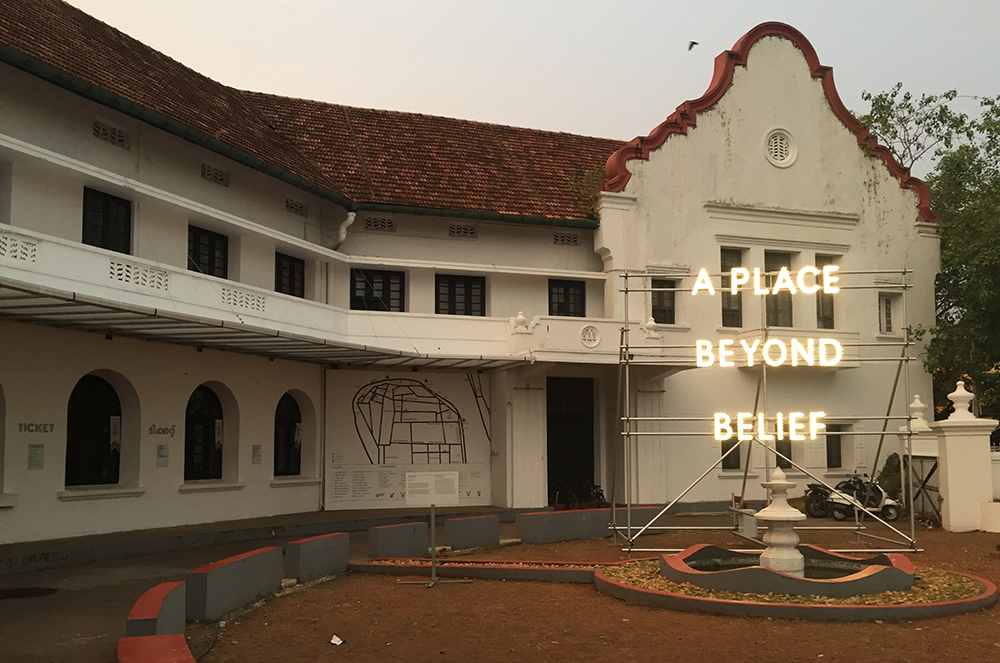
Last December, COP24 began in Katowice with a set of warnings. The proceedings—formally known as the Twenty-Fourth Conference of the Parties to the United Nations Framework Convention on Climate Change—opened with the UN Secretary-General António Guterres declaring that climate change is a “matter of life and death” and “we are still not doing enough.”5 This event followed the G20 Summit held two weeks earlier in Buenos Aires, where President Donald Trump had refused to sign a collective statement reaffirming support for the Paris Agreement. He was the sole world leader to refrain. At COP24, around twenty-three thousand delegates, observer organizations, and delegates participated in two weeks of intense official negotiations or critical collective protest actions.
The primary mandate for COP24 was to finalize the “Paris Rulebook,” often described as an “operating manual” for implementing the global climate accord in 2020. Before the conference, warnings also came in the form of various climate reports. Most notably, the UN’s most recent Intergovernmental Panel on Climate Change (IPCC) report had been released in October. It caused a worldwide stir, stating there are only twelve years left to limit global temperature increase to a maximum of 1.5C and avoid the devastating impacts of global warming. A second report from the Global Carbon Project demonstrated that global emissions within the last five years were escalating upward and that in 2018 fossil-fuel-related emissions will likely grow as much as 2.7 percent, the fastest increase in seven years.6 Among these and other warnings, COP24 participants gathered in Katowice, a city founded on coal mining.
The Kochi-Muziris Biennale was haunted by its own recent climate catastrophe that should also be seen as a dire forewarning. Around three months before the Biennale opened in mid-December, the surrounding areas of Kochi and other parts of Kerala were devastated with unprecedented floods. The flooding was caused by extreme weather that produced heavy monsoon rainfalls. On average, 30 percent excess rainfalls were recorded with some parts of the area receiving up to 70 to 90 percent excess. The result was massive and widespread flooding. According to state reports, Kerala had not experienced this level of flooding in almost a hundred years. By the end of August, it was estimated that more than 450 people had died and over a million were displaced and in relief camps. Thousands of homes, buildings, roads, and other infrastructure had been destroyed.
The causes for the severe flooding were attributed to several factors including unsustainable urban development, climate change, deforestation, rising reservoirs, low-quality dams, and poor planning.7 The Kochi Airport, which gained high recognition as the first airport in the world to run entirely on solar power, was forced to close for two weeks due to severe water damage. While the airport exemplifies large-scale solar energy use in complex buildings, ironically, it suffered from poor site planning. Built on a floodplain near a realigned river in low-lying areas, the site is mired with drainage problems and other issues. These floods, previously unimagined, haunt the Biennale. Yet with great effort it proceeded and resulted in a remarkable exhibition at multiple sites throughout Kochi.
Katowice is often described as the “heart” of Poland’s coal mining industry. Its revitalized industrial area, named “Cultural Zone,” was a charged setting for COP24. Inside the conference venues were pavilions showcasing everything from walls and floors to soaps and earrings made from coal. They were a part of a branding strategy by Polish state-owned coal-sector companies that had sponsored parts of the talks. Poland even announced the opening of a new coal mine during the weeks of COP24. One cannot help but wonder about the impact of this contexture on the COP24 participants. Is this city, as a kind of a “museum” for coal, an ideal or inherently flawed setting for a climate conference? And if a state is a coal-industry promoter, does it deter or activate the participants’ goals? For the activists at the conference, perhaps the settings could not be a more perfect background for their chants: “wake up” and “clean coal is a dirty lie.” Another remarkable moment occurred when some protesters infiltrated the Trump administration’s only side event, which was used to promote expanded use of fossil fuels. In the midst of the event, a large number of audience members got up from their seats and walked out of the room shouting chants of “Shame on you!” and “Keep it in the ground!” Once they left, the room was largely left empty.
The optics of spaces, words, and actions can send subtle signals or trigger larger impacts. For example, the final language used in the rulebook does not “welcome” the IPCC report but only “notes” it. Somehow, four countries (United States, Russia, Saudi Arabia, and Kuwait) succeeded in enforcing this wording against 193 other countries. Conversely, many delegates worked together successfully to replace instances of “should” with “shall” in the report. This was necessary, as the use of “should” is looser while “shall” is legally binding. The issues that countries fought over, and the divides between rich versus poor countries, were not surprising.8 Major sources of conflict included transparency in climate reporting and climate financing.9 No consensus was achieved on either issue, or on what and how to report on emissions, or how to set global policies on funding provisions. Should there be the same “common rules” for all countries, or should there be “nationally appropriate methodologies” for reporting? What accounting mechanisms will be in place to track “polluting countries” in their pledges toward financing climate adaptation? Should they also include “loss and damage” caused by unavoidable climate impacts? That consensus around these kinds of questions would prove impossible was predicted by the activists. Outside the conference, a large banner read “System Change not Climate Change,” as the protesters gathered in the Culture Zone of Katowice.
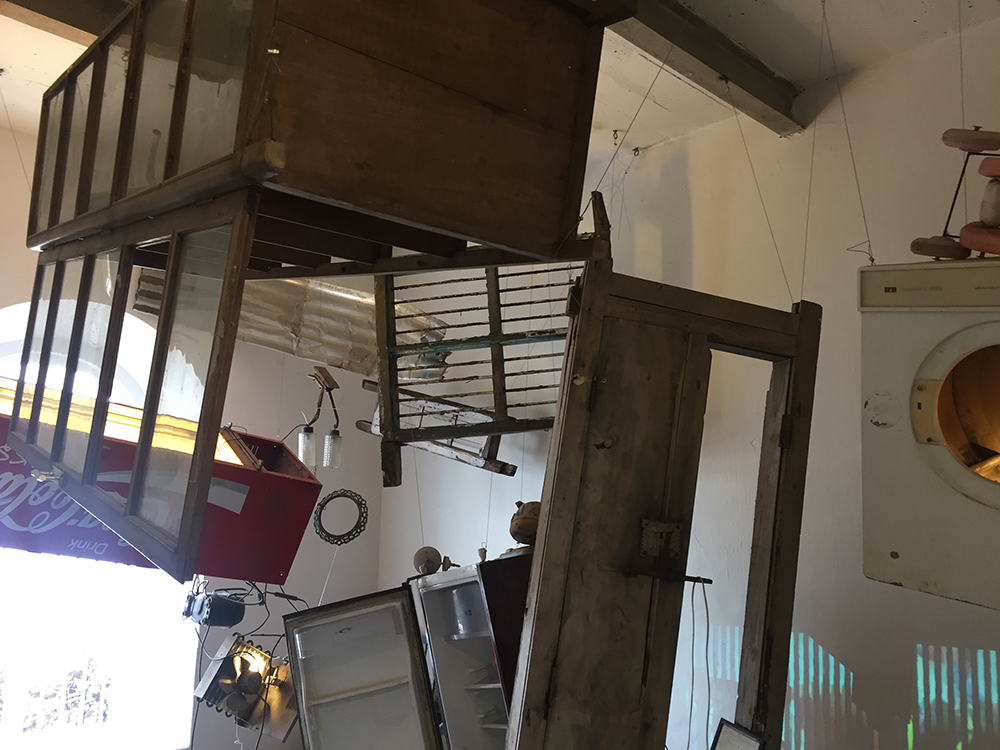
At the Kochi-Muziris Biennale, Dube’s curatorial framework inspired some artists to integrate a response to the Kerala Floods. In their installations, one might say that “loss and damage” came into view, if only for a brief glimpse. Marzia Farhana’s (Bangladesh) large installation Ecocide and the Rise of Free Fall, was made with objects—TVs, washing machines, chairs, shelves, soiled newspapers and books, clocks, etc.—collected from the flood-affected areas. The objects hung from the ceiling, floated at precarious angles, and recreated the disorienting worlds of climate catastrophe as well as consumer products gone awry. Another project, The Clothesline by Monica Mayer (Mexico), collected written notes from participants about their experiences of trauma from the Kerala floods. These notes, along with others on experiences of sexual trauma from participants in Mexico City and Kerala, were displayed on a clothesline. Another somewhat theatrical, very large installation was based on a 2001 film Memorial Project Nha Tang, Vietnam by Nguyen-Hatsushiba (Japan). The film was projected in a room filled with two feet of water. Viewers waded through the water to sit on benches and watch a film showing drivers pedaling Cyclos (three-wheel taxis) on a shallow ocean floor and periodically coming up for air. The artists’ approaches here focused on recreating “experiences” for viewers as if to say, “What if you had to go through these circumstances?”
As artists responding to the floods, one highly noteworthy project by the artist collective Oorali (Kerala) was tucked away in a smaller room. With their unique bus named Express, the collective traveled to and performed in villages affected by the floods. Their bus transforms between a stage, a workshop, and an office, and they directly involve fisherman communities that were at the forefront of the flood in rescuing trapped victims with their boats. A video documenting their journeys showed how they engaged with communities through music and art performances and provided an original platform for people to document their experiences. In varying degrees, these art installations were cautionary reminders of a devastating climate tragedy that in many ways already seemed to be long past, especially given the vibrant holiday festivities that transform Kochi’s streets in December.
In Katowice, the activists and participants representing civil and social organizations performed with vigor and creativity to raise issues of climate justice and to demand urgent actions on climate crises. The sentiment that this “conference of parties” should not turn into a “conference of polluters” was repeated by negotiators as well as protesters. In the middle of conference talks, a protest march drew almost three thousand people (and was overseen by almost half that number of police). Greta Thunburg, a Swedish high-school student who has since become a face of the youth movement, addressed the plenary in a matter-of-fact way with direct phrases like “Change is coming whether they like it or not,” and “Since our leaders are behaving like children, we will have to take the responsibility they should have taken long ago.” Her remarks and activism have inspired worldwide school walkouts.
A wide range of climate activists, including international stalwart media and NGOs such as Greenpeace and ActionAid, were at this COP as they had been at many previous ones, influencing official talks inside the work sessions and reporting from the hallways. This was Democracy Now!’s (an independent news hour) tenth COP summit. The host, Amy Goodman, in an athletic act of reporting, chased Wells Griffith, one of Trump’s chief representatives, for almost a half mile, including up and down several stairs. As she attempted to question him on the Trump administration’s climate policy, he ran from her and her camera team refusing to answer any questions. It resulted in a memorable counter-agitprop-meets-absurdist-comedy action that can only be seen as a huge embarrassment for the special assistant to the president for international energy and environment.10 In these and other ways, protesters consistently infiltrated and occupied Katowice’s Cultural Zone.
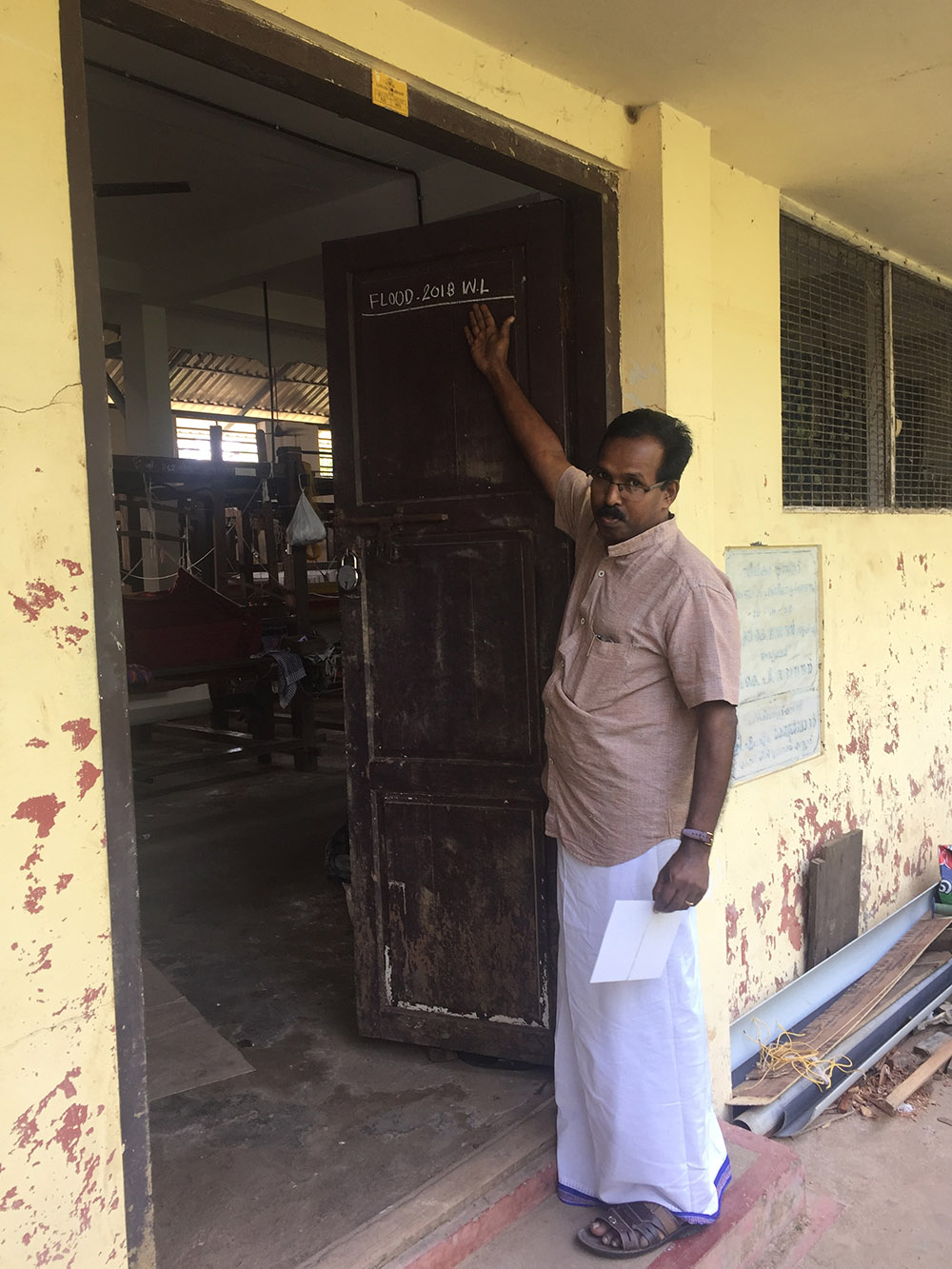
A small shop at Aspinwall, the Kochi-Muziris Biennale’s main location, sold small items made by artisans affected by the Kerala Floods. With a volunteer from the shop, I ventured on a trip to Chedamangalam, a weaver’s village around forty kilometers outside Kochi. There the artisan workshops are filled with piles of damaged looms, soiled yarn, and broken materials. As the workshop manager showed me around, he pointed to water levels they had recorded during the floods—lines drawn up to seven to ten feet high on the walls. We also visited houses where weavers work on looms set up outside in semi-open areas. Not very far away were the creeks that had swelled with overflowing water just a few months before. Chedamangalam and other villages up and down the coast are crossed by networks of rivers and ocean inlets. While the heavy monsoons and varying water levels are something they have dealt with for decades, the manager said the floods in August were unimaginable. When asked what the community will do if it happens again, he only shrugged and smiled.
The workshop manager had been making mental notes and tracking financial aid figures from various governmental and international relief organizations. He said he had been following news and community discussions related to the flood relief efforts, but it wasn’t clear to him how much of the aid will reach the weavers’ workshops. At this point, only a handful of women are re-employed. According to the nonprofit group Save the Loom, 90 percent of the workforce at the weavers’ center are women, and many are sole income earners for their family.11 Save the Loom has worked hard to set up artisanal cooperatives and to encourage high-fashion designers to use hand-loomed fabrics. In a gallery/store in Kochi, I saw some impressive clothing by fashion designers that worked with the artisanal cooperatives. Their products were priced for local and international ultra-upscale markets. A laudable effort, it remains very difficult to discern the actual percentages of earnings that go back to the weavers in the villages. Driving back to Kochi from Chendamangalam, I was struck by the shifting scenes, from lush backwater landscapes to beautiful vernacular homes to magnificent temples and synagogues to mega industrial seaport infrastructures.
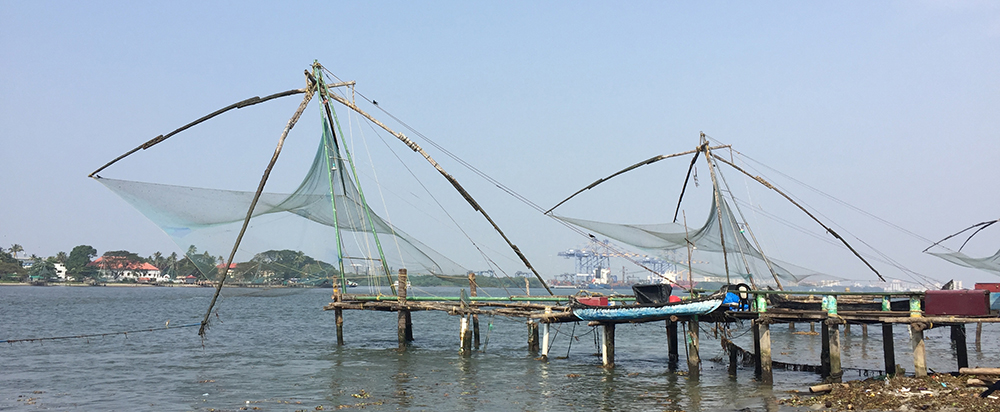
At the Katowice climate talks, climate finance was a thorny topic in many areas. What countries are responsible for financial provisions? How are their pledges reported and accounted? What should be the new goals for climate finance? Increasingly, displacement and migration, both within and across countries due to climate change, are discussed within larger “loss and damage” equations. The Internal Displacement Monitoring Center (IDMC) reports eighteen million people were displaced in 2017 due to weather-related disasters.12 And according to some other agencies, including the World Bank, over one hundred million people could be forced to migrate within or outside the Global South by 2050.
A task force was set up to address climate displacement, but little progress was made. As reported by CarbonBrief, Harjeet Singh, a representative from ActionAid, commented to their reporters that the term “address” might be a misnomer since there are “no legal protections available to climate displaced people.”13 For him, unless mechanisms of “loss and damage” also include financial resources for addressing displacement due to climate change, not much can be achieved. Ultimately, all this leads to larger issues, in climate-talk-speak, of differentiated “common responsibility” of climate finance. This concept was well explained by Mohamed Nasheed, the former president of the Maldives, in an interview by Democracy Now! during the COP24 talks: “Developing countries, such as the Maldives, did not contribute to climate change, but we are the first to suffer from it. So, we have to differentiate our responsibility and of a big emitting country such as the United States.”14
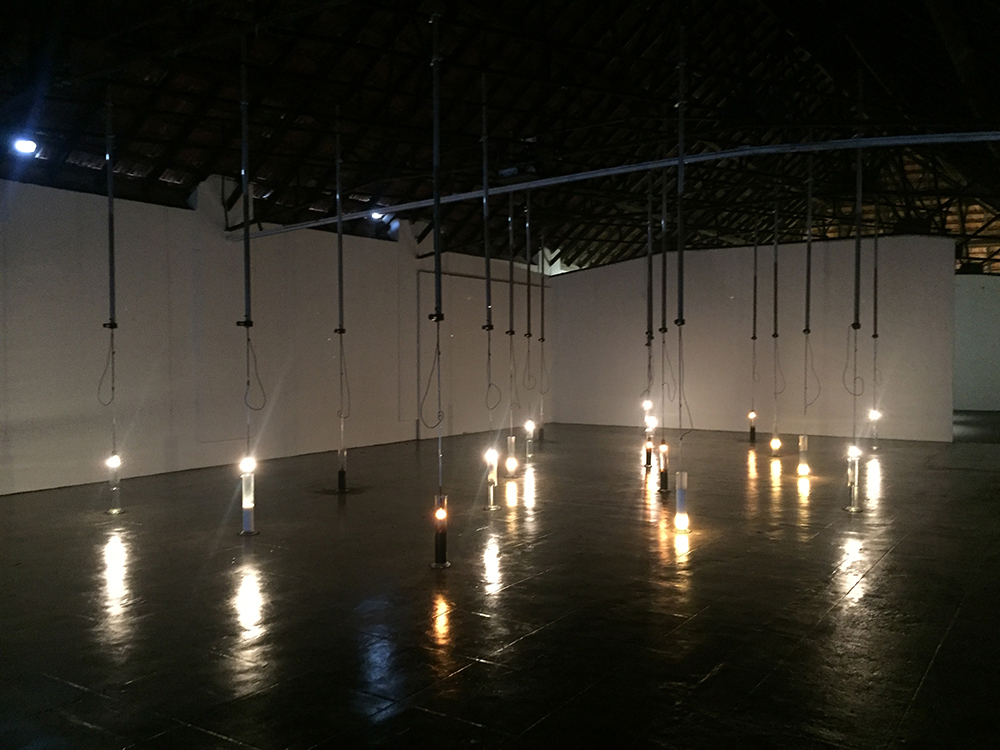
The Kochi-Muziris Biennale art projects brought artistic attention to migration, activism, and power. Like many other global art exhibitions, this one had its share of large-scale multimedia installations in dark warehouse spaces. A magical “sensorium” was created by William Kentridge (South Africa) with a linear, eight-screen film projection, titled More Sweetly Play the Dance. It showed silhouetted figures dancing in a procession, carrying cutouts of his drawings to festive sounds of a brass band. The piece evoked references to both refugees migrating and protest marches. And while it was easy to be subsumed by the magic of it all, one longed for more specific relations to contemporary geopolitics or to the immediate context of Kochi/Kerala—or, for that matter, to any other location. VALIE EXPORT’s (Austria) installation Fragments of Images of Contingence, originally created in 1994, seemed even more relevant today. It consisted of glass cylinders filled with milk, oil, or water into which light bulbs suspended from the ceiling moved up and down, dipping into the liquids. The perceived risks of electricity mixing with liquids, and the extensive distribution of twenty-four cylinders on the floor, created a visual drama that seemed surreally beautiful and cautiously dangerous at the same time.
Notable other works included iconic and recently updated feminist-activist social critiques. Sonia Khurana’s (New Delhi) video Bird (1999) depicted her naked body perched on a pedestal, falling and tumbling as she tried to fly. Her recent multi-channel video Body Event (2018) showed imprints of her body lying down in public spaces in different cities. The Guerrilla Girls (New York) updated their classic posters and translated them into Malayalam. And Martha Rosler (New York) exhibited her influential series of photomontages House Beautiful: Bringing the War Home (1960–70) that she expanded in 2004. The montages portray magazine advertisements and war images, first from the Vietnam War and later from Afghanistan and Iraq, intermingling consumerism and warfare. This body of work highlighted different conceptual approaches and visual engagements with notions of the personal, political, institutional, commercial, and imperial. In Kochi, the experience of this work was further reshaped by, among other things, the striking waterfront views from the Biennale’s galleries, which created unexpected juxtapositions. “Chinese” fishing nets, small boats, ferries, etc., could be seen next to giant cranes and other industrial infrastructure across the river from one of the largest seaports in the region, operated by Dubai Ports World. At one point, I saw a massive container ship with over a thousand containers calmly floating by the Biennale site.
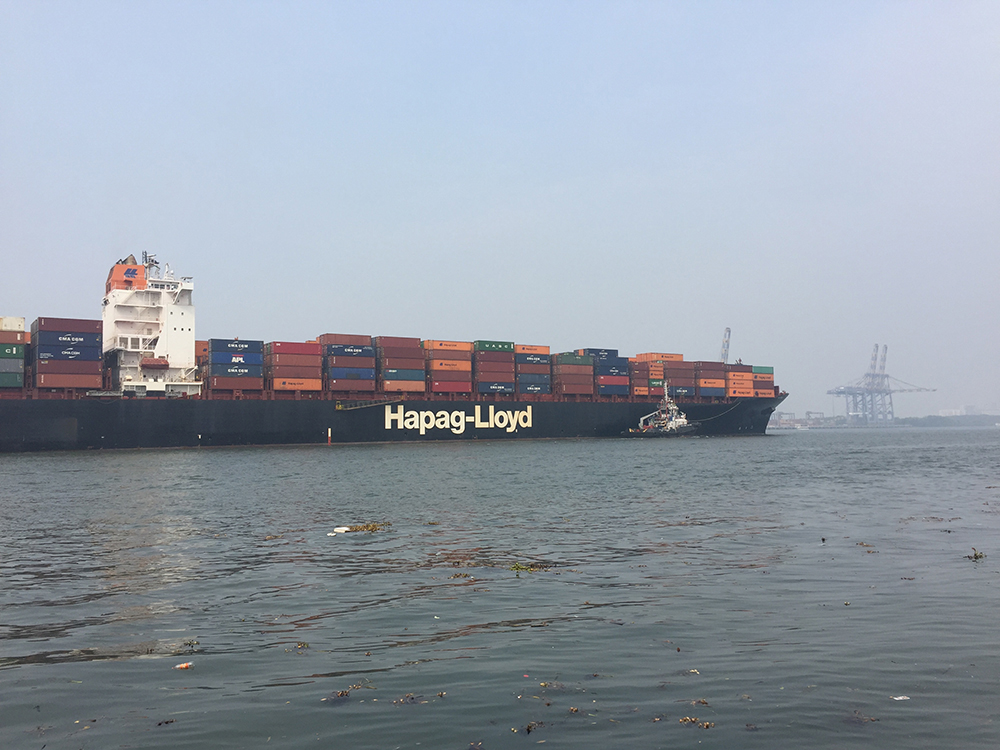
The Katowice Climate Summit took place in the Spodek Arena, a flying-saucer-shaped stadium from the 1970s, and the International Congress Center (ICC), completed in 2015 and designed by Warsaw-based architect Jems Architekci. These buildings are a part of the Cultural Zone that transformed the former coal mining area into “a sort of mine of culture.”15 The ICC is a black rectangular building that, as the architects describe, “is intersected by a ‘canyon’ linking the entrance courtyard facing the Spodek arena” to the city’s historic areas.16 The pedestrian “canyon” is formed by a “green valley” with faceted, grassy surfaces. It’s an elegant project that integrates crucial urbanistic connections with a dynamic public space. Interesting to note, however, the architects’ statements avoid all references to coal, while others see the evocation of a coal mine—referring to the black building, walls, and interiors covered with black metal mesh.17 I would consider even the “green” faceted surfaces as visual reminders of coal’s rock textures or the walls of a coal mine.
These kinds of dichotomies are particularly exaggerated at this climate summit. A global “meet” of this kind can easily turn into a convention for industry and business interests allied with state and multinational powers. At this event, many representatives from fossil-fuel companies showed up in force, including a lobbying group that represents BP, Shell, and ExxonMobil. Maya Menezes, a Canadian climate activist, reported on the protesters’ calls for the “decorporatization of the COP” with background chants of protesters shouting “Keep polluters out of COP!”18
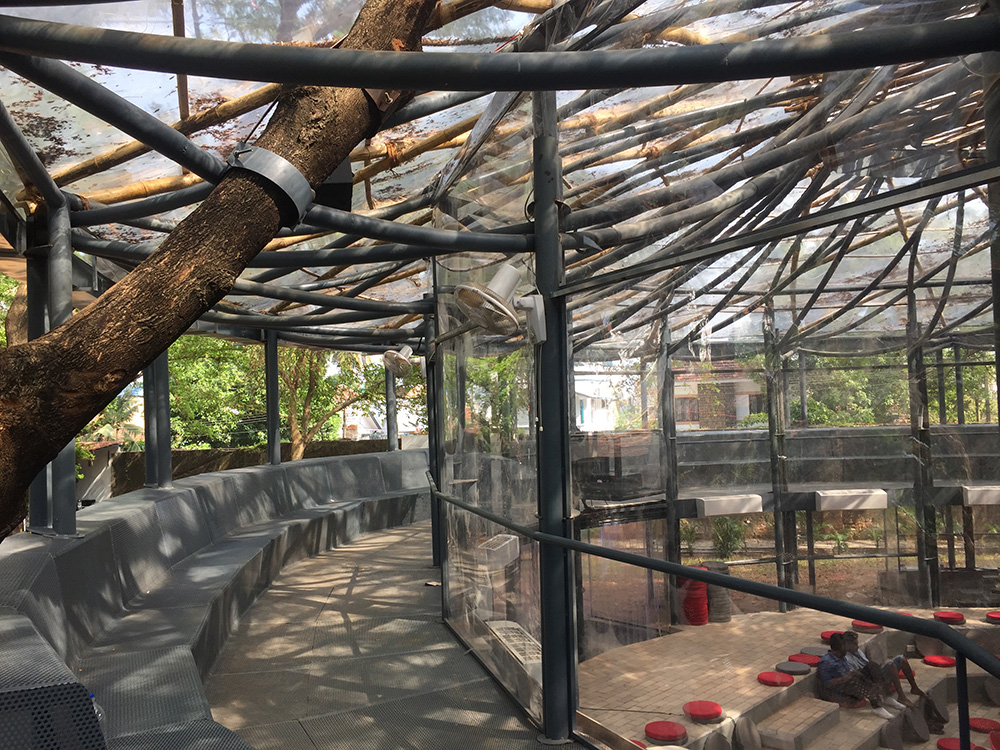
A central component of the Kochi-Muziris Art Biennale was a pavilion that Dube envisioned as a “knowledge laboratory.” Designed by New Delhi–based Anagram Architects, it was located in Carbal Yard, an open, urban space in a dense part of the city. This impressive, circular semi-open structure, made with bamboo and steel, housed a multipurpose amphitheater. A terrific program of daily events including performances, film screenings, talks, and workshops was planned for the entire duration of the Biennale. It became a cultural hub where residents, visitors, and artists interacted in planned and informal activities. Walking around this hub and the different Biennale venues, the diverse cultural vibe of the city with temples, churches, mosques, and synagogues is palpable. So are the intense layers of colonial histories embedded in buildings built by the Dutch, Portuguese, and British. Also evident are the changing dynamics of the city with boutique hotels, home-stay guesthouses, and high-end tourist shops having sprung up recently, in part spurred by the presence of the Biennale. What is the future of such a city? Is it heading in the direction of a city like Venice, a museum city, mostly for tourists and international art events?
The Kochi-Muziris Biennale will end on March 28. The “knowledge laboratory” pavilion will be dismantled. The Kochi Biennale Foundation has promised to recycle the materials and donate them to Kerala flood relief efforts. According to the architects, “the construction materials can build a dozen houses of around 600 square feet each.”19 It will be interesting to see how this gesture develops. What will the houses look like? Where will they be located? Are they being discussed with those who may live in these houses? The foundation also organized an international art auction and raised funds from donations. These initiatives are admirable as a short-term response to a climate tragedy. Though, given the climate crises, how can the foundation and the upcoming biennales act as a laboratory for addressing the long-term future? Can art play a role? And this is where we might both learn from Dube’s curatorial vision and strive to advance it further. Her inspirations and wanderings gathered a myriad of art practices that focused on connecting the past to the present. This, for me, emerged as a clear thrust of this Biennale. And now we must ask, how do these connections link to the future?
The Katowice Climate Summit ended after a marathon session (and after the deadline to complete the rulebook was extended for a day). It was reported that 195 countries reached an agreement to adopt the Paris Rulebook. This global accord will enter into force in 2020. While some called the rulebook a solid action, I agree with many others who call it a yet another weak and compromised deal in the face of a crisis that can only be described as immediate. I side with those who insist that the system is broken. I add my voice to the crowd chanting “system change not climate change.” And to those who interfered with the urgent global action on climate change, this is the warning coming out of Katowice—among the multitudes present at the Katowice Climate Summit, there were many young faces. And their voices are getting louder and louder.
From the cautionary tales and novel voices at the art exhibit and the climate summit, I concluded that struggles and crises do not just end on their own, and perhaps the climate ones are just beginning. Now that the last year is fading away, and a new one is under way, there will be more biennales and additional climate talks. And to gear up for all that is to come, I draw your attention to two voices, in the form of textual snippets. The first few lines are drawn from the last paragraph of Anita Dube’s curatorial introduction the Kochi-Muziris Biennale, followed by a single phrase from Greta Thunburg’s address to the plenary at the Katowice Climate Summit.
Imagine those pushed to the margins of dominant narratives speaking: not as victims, but as futurisms’ cunning and sentient sentinels. And before speaking, listening to the stone and the flowers; to older women and wise men; to the queer community; to critical voices in the mainstream; to the whispers and warnings of nature.
If we desire a better life on this earth—our unique and beautiful planet—we must in all humility start to reject an existence in the service of capital.20
We cannot solve a crisis without treating it as a crisis.21
Please listen carefully.
-
These notes are based on my weeklong visit to the Kochi-Muziris Biennale in December 2018 and on my review of various news reports, organizational websites, and social media feeds related to the Katowice COP24 Climate Summit from December 2 to 18, 2018. See the organizational websites for both events here and here. ↩
-
Anita Dube interviewed by Anannya Sarkar, “A Peek into the 4th Kochi-Muziris Biennale,” the Telegraph (online edition), November 25, 2018, link. ↩
-
Anita Dube, “Possibilities for a Non-Alienated Life,” Concept, Kochi-Muziris Biennale 2018, December 2018, link. ↩
-
Anita Dube, “Midnight Dreams: The Tragedy of a Lone Revolutionary,” Afterall: A Journal of Art, Context, and Enquiry, vol. 36 (June 2014): 40–53, link. ↩
-
António Guterres, “Remarks at the opening of the COP 24,” United Nations Secretary-General, December 3, 2018, link. ↩
-
For more information, see press release: Global Carbon Project, December 5, 2018, link. ↩
-
See explanations on some of these factors in Samrat Basak, Sahana Goswami, and Raj Bhagat Palanichamy, “Kerala Flooding: Natural Calamity or Manmade Disaster?,” WRI India, September 3, 2018, link. ↩
-
For detailed descriptions of climate negotiations at COP24, see CarbonBrief, “COP24: Key Outcomes Agreed at the UN Climate Talks in Katowice,” report, December 16, 2018, link. ↩
-
For information on climate finance, see the United Nations Climate Change website, link. ↩
-
See Global Report on Internal Displacement 2018, Internal Displacement Monitoring Center website, link. ↩
-
CarbonBrief, “COP24: Key Outcomes Agreed at the UN Climate Talks in Katowice,” link. ↩
-
See Mohamed Nasheed’s video interview on Democracy Now!, December 14, 2018, link. ↩
-
“Discover Katowice: Culture Zone,” COP24 Katowice 2018 website, link. ↩
-
For more project information, see Jems Architekci website, International Congress Center, link. ↩
-
These references were noted in participants’ and reporters’ descriptions of the conference surroundings. See an architectural review of the center here. ↩
-
See Maya Menezes’ video interview on Democracy Now!, December 14, 2018, link. ↩
-
Dube, “Possibilities for a Non-Alienated Life.” ↩
-
Greta Thunberg, speech at UN Climate Change COP24 Conference, December 13, 2018, link. ↩
Kadambari Baxi is an architect and educator. She is currently working on multimedia projects on climate change internationalisms and activism. She is professor of practice at Barnard and Columbia College Architecture Department. Her website is www.kbaxi.net.

